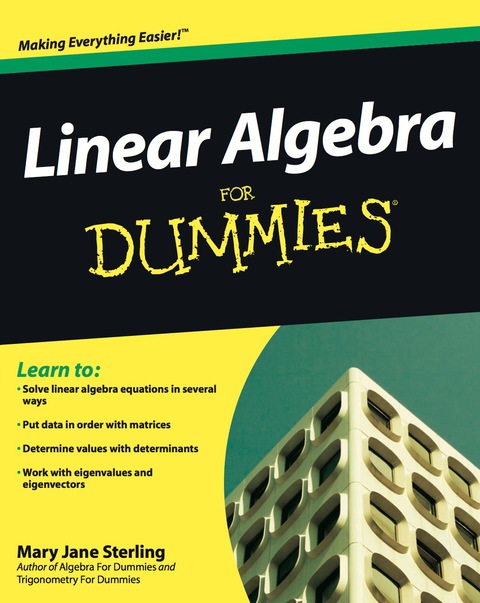Description
Efnisyfirlit
- About the Author
- Dedication
- Author’s Acknowledgments
- Contents at a Glance
- Table of Contents
- Introduction
- About This Book
- Conventions Used in This Book
- What You’re Not to Read
- Foolish Assumptions
- How This Book Is Organized
- Icons Used in This Book
- Where to Go from Here
- Part I: Lining Up the Basics of Linear Algebra
- Chapter 1: Putting a Name to Linear Algebra
- Solving Systems of Equations in Every Which Way but Loose
- Matchmaking by Arranging Data in Matrices
- Valuating Vector Spaces
- Determining Values with Determinants
- Zeroing In on Eigenvalues and Eigenvectors
- Chapter 2: The Value of Involving Vectors
- Describing Vectors in the Plane
- Defining the Algebraic and Geometric Properties of Vectors
- Managing a Vector’s Magnitude
- Chapter 3: Mastering Matrices and Matrix Algebra
- Getting Down and Dirty with Matrix Basics
- Putting Matrix Operations on the Schedule
- Putting Labels to the Types of Matrices
- Connecting It All with Matrix Algebra
- Investigating the Inverse of a Matrix
- Chapter 4: Getting Systematic with Systems of Equations
- Investigating Solutions for Systems
- Dealing with Inconsistent Systems and No Solution
- Solving Systems Algebraically
- Revisiting Systems of Equations Using Matrices
- Part II: Relating Vectors and Linear Transformations
- Chapter 5: Lining Up Linear Combinations
- Defining Linear Combinations of Vectors
- Getting Your Attention with Span
- Chapter 6: Investigating the Matrix Equation AX=b
- Working Through Matrix-Vector Products
- Confirming the Existence of a Solution or Solutions
- Chapter 7: Homing In on Homogeneous Systems and Linear Independence
- Seeking Solutions of Homogeneous Systems
- Delving Into Linear Independence
- Connecting Everything to Basis
- Chapter 8: Making Changes with Linear Transformations
- Formulating Linear Transformations
- Proposing Properties of Linear Transformations
- Writing the Matrix of a Linear Transformation
- Determining the Kernel and Range of a Linear Transformation
- Part III: Evaluating Determinants
- Chapter 9: Keeping Things in Order with Permutations
- Computing and Investigating Permutations
- Involving Inversions in the Counting
- Chapter 10: Determining Values of Determinants
- Evaluating the Determinants of 2 × 2 Matrices
- Using Determinants with Area and Volume
- Chapter 11: Personalizing the Properties of Determinants
- Transposing and Inverting Determinants
- Interchanging Rows or Columns
- Zeroing In on Zero Determinants
- Manipulating Matrices by Multiplying and Combining
- Taking on Upper or Lower Triangular Matrices
- Determinants of Matrix Products
- Chapter 12: Taking Advantage of Cramer’s Rule
- Inviting Inverses to the Party with Determined Determinants
- Solving Systems Using Cramer’s Rule
- Recognizing and Dealing with a Nonanswer
- Making a Case for Calculators and Computer Programs
- Part IV: Involving Vector Spaces
- Chapter 13: Promoting the Properties of Vector Spaces
- Delving into the Vector Space
- Describing the Two Operations
- Singling Out the Specifics of Vector Space Properties
- Chapter 14: Seeking Out Subspaces of a Vector Space
- Investigating Properties Associated with Subspaces
- Finding a Spanning Set for a Vector Space
- Defining and Using the Column Space
- Connecting Null Space and Column Space
- Chapter 15: Scoring Big with Vector Space Bases
- Going Geometric with Vector Spaces
- Creating Bases from Spanning Sets
- Making the Right Moves with Orthogonal Bases
- Writing the Same Vector after Changing Bases
- Chapter 16: Eyeing Eigenvalues and Eigenvectors
- Defining Eigenvalues and Eigenvectors
- Solving for Eigenvalues and Eigenvectors
- Circling Around Special Circumstances
- Getting It Straight with Diagonalization
- Part V: The Part of Tens
- Chapter 17: Ten Real-World Applications Using Matrices
- Controlling Traffic
- Catching Up with Predator-Prey
- Creating a Secret Message
- Saving the Spotted Owl
- Migrating Populations
- Plotting Genetic Code
- Distributing the Heat
- Making Economical Plans
- Playing Games with Matrices
- Eating Right
- Chapter 18: Ten (Or So) Linear Algebra Processes You Can Do on Your Calculator
- Letting the Graph of Lines Solve a System of Equations
- Making the Most of Matrices
- Performing Row Operations
- Raising to Powers and Finding Inverses
- Determining the Results of a Markov Chain
- Solving Systems Using A–1*B
- Adjusting for a Particular Place Value
- Chapter 19: Ten Mathematical Meanings of Greek Letters
- Insisting That π Are Round
- Determining the Difference with Δ
- Summing It Up with Σ
- Row, Row, Row Your Boat with ρ
- Taking on Angles with θ
- Looking for a Little Variation with ε
- Taking a Moment with μ
- Looking for Mary’s Little λ
- Wearing Your ΦΒΚ Key
- Coming to the End with ω
- Glossary
- Index






